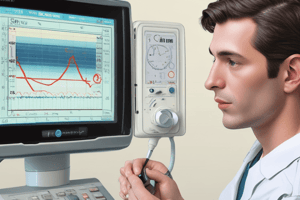Podcast
Questions and Answers
What is the gold standard for arterial blood pressure measurement?
What is the gold standard for arterial blood pressure measurement?
- Invasive monitoring (correct)
- Non-invasive monitoring
- Auscultatory methods
- Automated Oscillometry
Which technique involves selecting an artery for cannulation, usually the radial artery, and connecting it to a transducer through high-pressure tubing?
Which technique involves selecting an artery for cannulation, usually the radial artery, and connecting it to a transducer through high-pressure tubing?
- Continuous observation
- Infusion therapy
- Arterial blood sampling (correct)
- Auscultatory method
What is the normal range of CVP pressure in adults?
What is the normal range of CVP pressure in adults?
- 1 to 5 cm H2O
- 15 to 20 cm H2O
- 10 to 15 cm H2O
- 5 to 10 cm H2O (correct)
Which condition warrants replacing blood loss by blood transfusion in adults?
Which condition warrants replacing blood loss by blood transfusion in adults?
What is a complication of arterial cannulation involving damage to nerves?
What is a complication of arterial cannulation involving damage to nerves?
Which is NOT a disadvantage of non-invasive monitoring?
Which is NOT a disadvantage of non-invasive monitoring?
What is indicated for surgeries with wide blood pressure swings and end-organ diseases patients?
What is indicated for surgeries with wide blood pressure swings and end-organ diseases patients?
Flashcards
Peripheral Nerve Stimulation
Peripheral Nerve Stimulation
Device that assesses neuromuscular blockade by stimulating a motor nerve and evaluating muscle contractions.
Daily Body Water Exchange (Adults)
Daily Body Water Exchange (Adults)
Adults exchange about 5% of total body water daily, making them less prone to dehydration than infants.
Signs of ECF Volume Deficit
Signs of ECF Volume Deficit
Dry mouth, sunken eyes, decreased skin turgor, and orthostatic hypotension.
Basal Hourly Fluid Requirement
Basal Hourly Fluid Requirement
Signup and view all the flashcards
Essential Anesthesia Monitoring
Essential Anesthesia Monitoring
Signup and view all the flashcards
ECG Use in Anesthesia
ECG Use in Anesthesia
Signup and view all the flashcards
Invasive Blood Pressure Monitoring
Invasive Blood Pressure Monitoring
Signup and view all the flashcards
Study Notes
Anesthesia and Monitoring
- Warm all transfused fluids, blood products, and irrigation solutions to prevent hypothermia.
Peripheral Nerve Stimulation
- A device used to assess the degree of neuromuscular blockade by stimulating a motor nerve and evaluating muscle contractions.
- Used during general anesthesia to measure muscle relaxation, detect time for the next dose of muscle relaxant, and measure reversal of neuromuscular blockade before endotracheal extubation.
- Used during regional anesthesia to locate the proper anatomical site of a nerve to be blocked.
Fluid Balance and Replacement
- A healthy adult can balance daily fluid input and output of 2.5L H2O/day/70 kg.
- Adults exchange about 5% of total body water per day, while infants exchange about 15%, making them more prone to dehydration.
- ECF volume deficit can be detected by signs such as dry mouth, thirst, sunken eyes, decreased skin turgor, drowsiness, oliguria, orthostatic hypotension, tachycardia, tachypnea, cool extremities, low CVP, and metabolic acidosis.
- Intraoperative fluid replacement includes basal hourly requirement, preoperative fluid deficits, and operative fluid loss.
- Basal hourly requirement is calculated according to the "4-2-1" rule (4ml/kg/hr for 20kg).
Monitoring
- Anesthesiologists must be present throughout general, local, and monitored anesthesia care.
- Monitoring should be present before induction and continued until patient recovery.
- Monitoring equipment must be checked before usage.
- Essential monitoring for all cases includes:
- Clinical observation
- Peripheral pulse
- ECG
- Non-Invasive blood pressure
- Pulse oximetry
- End tidal Co2
- Neuromuscular monitoring (especially if muscle relaxant is used)
- Temperature monitoring (if the patient is at risk of hypothermia or hyperthermia)
Cardiac Function and Monitoring
- Radial or carotid pulsation palpation is the gold standard clinical assessment for cardiac function.
- Capillary refill time is normally less than 2 seconds.
- Observation of extremities color and temperature is important.
- Pao2, PaCo2, and Serum lactate (normally less than 2mmolL) are important indicators.
- Urine output (normally 0.5 to 1 ml/Kg/hr) indicates cardiac function.
- ECG is used to detect arrhythmia, especially by lead II, MI, heart block, and other conduction problems.
- Heart rhythms associated with cardiac arrest include shockable rhythm (VF and pulseless VT) and non-shockable rhythm (Asystole and Pulseless electrical activity).
Blood Pressure Monitoring
- Non-invasive monitoring is indicated for all patients and should be done every 5 minutes.
- It can be monitored through palpation, auscultatory methods, or automated Oscillometry.
- Disadvantages of non-invasive monitoring include inaccuracy, especially at extreme values, and unsuitability for rapid blood pressure changes.
- Invasive monitoring is the gold standard for arterial blood pressure measurement and provides continuous beat-to-beat pressure changes.
- Invasive monitoring is indicated for surgeries with wide blood pressure swings, elective hypotension, and end-organ diseases patients.
Arterial Cannulation
- The radial artery is usually selected for cannulation.
- The cannula is connected through a stopcock and saline-filled high-pressure tubing to a transducer.
- Complications of arterial cannulation include hematoma, vasospasm, thrombosis, nerve damage, and infections.
- Arterial cannulation is used for infusion of fluid or drugs, measuring CVP pressure, and arterial blood sampling.
Studying That Suits You
Use AI to generate personalized quizzes and flashcards to suit your learning preferences.




